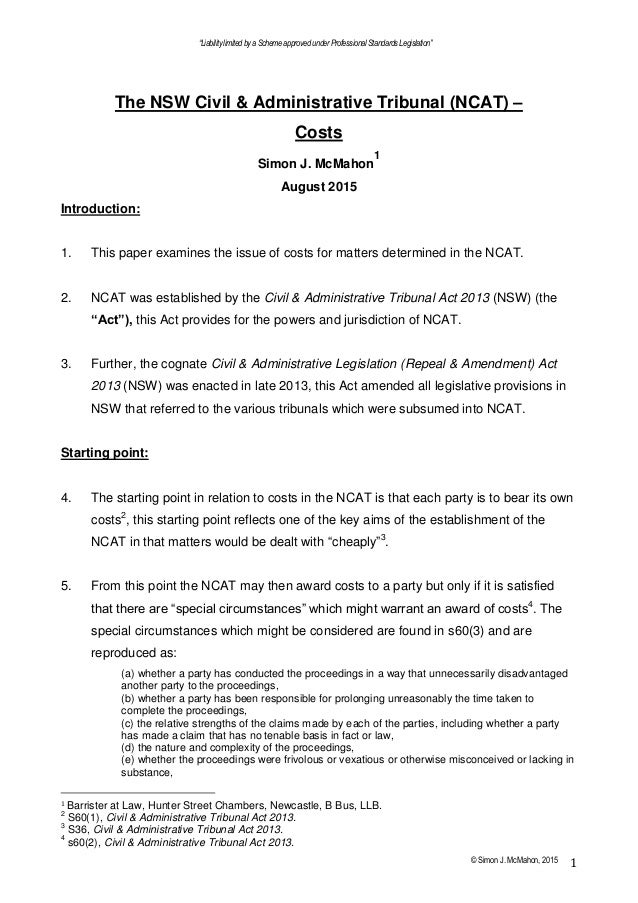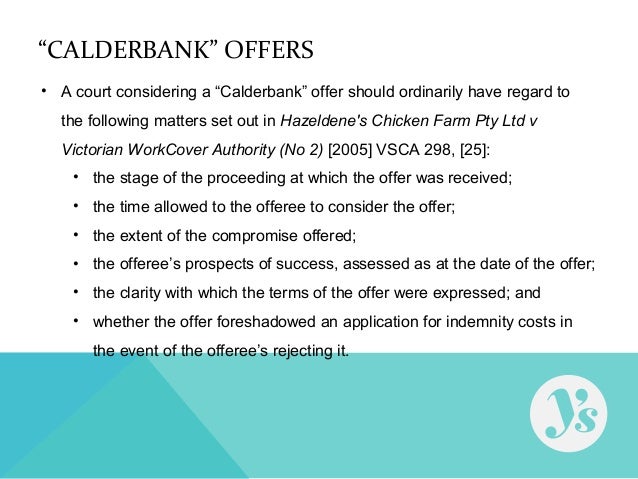However, there are still some circumstances in which Calderbank letters remain a useful mechanism. For more information, see Practice note, Calderbank offers, Standard documents, Calderbank letter from solicitors acting for a defendant (with drafting notes) and Without prejudice save as to costs settlement offer letter from a claimant (with.
A Calderbank offer (otherwise known as a 'Without Prejudice Save as to Costs') is an offer to settle a dispute, putting the other side on notice that, if the dispute goes before any court and the outcome is less favourable to the other side compared to the Calderbank Offer being made, then the side making the offer is entitled to more of their costs being recovered. Vmware fusion pro 8.5.1. This is because, if the other side had accepted the offer, then they would have been better off and neither side would have had to spend money taking the matter to court.
- It must state that it is “without prejudice save as to costs” and that it is made pursuant to the principles established in Calderbank v Calderbank (or a statement to that effect). “Without prejudice” means that the settlement offer is without prejudice to the party’s right to initiate or continue litigation, and the letter cannot be.
- Calderbank letter. A letter containing a settlement offer and written 'without prejudice save as to costs', that is with the express reservation of the right to refer the letter to the court on the question of costs if the offer is not accepted. Use of Calderbank letters has reduced significantly since the advent of Part 36 offers as they do.
- Calderbank letter template. 7/20/2018 0 Comments Contribution is for general information, is not intended to replace professional professional advice (medical, legal.
- A Calderbank offer is a letter written by one party, generally the Defendant, to the Plaintiff, making an offer to resolve the litigation. It should be marked “ without prejudice save as to costs ”, or else it may be shown to the Court at the outset, which could influence the Court’s views on both liability and quantum.
The history behind the Calderbank offer goes back to an English case in 1975 between Mr and Mrs Calderbank. It was summed up nicely by the court in a case called Martel:
Murgaa auto clicker. It was in a legislative vacuum that the English Court of Appeal made its ruling in Calderbank. Mrs. Calderbank was seeking a declaration under the Married Women's Property Act, 1882, not recovery of debt or damages. Before trial, she swore an affidavit declaring herself willing to accept a certain result in the litigation going on between herself and Mr. Calderbank. Mr. Calderbank did not agree and the case went to trial.
The judgment was less favourable to him than what Mrs. Calderbank had been willing to give him. It was held that Mrs. Calderbank was entitled to her costs, as from the date on which she made her willingness to settle known. The Court also suggested that a letter like the one used in this case by the plaintiff should sound in costs. What has become known as a Calderbank letter developed into a recognised procedure to set up an award of costs based on a willingness to settle.
In simple terms, when you make or reject a Calderbank offer, you are taking an educated bet. In terms of employment matters, when an employee makes a Calderbank offer, they are betting that the amount the ERA will award will be more than the employee's offer amount. If the employee is right, then they can apply to have more of their costs paid by the employer. However, should an employer make a Calderbank offer, then they are betting that the ERA will award the employee less than the amount they are offering.

Should the employer be right, then, even though the employee may have won the battle of that case, the employee may actually lose the war as they can have costs awarded against them. This is because the employee would have been better off if they had accepted the employer's offer and the employer would not have had to spend money on defending the claim.
Accordingly, Calderbank offers should not be made or rejected prior to taking employment law advice, as the outcome can have major implications on both sides. Do contact us with further queries you may have on this matter.
Posted: 24/02/2015
- The courts treat Part 36 and Part 44 “Calderbank” offers differently
- The courts apply a less rigid test under CPR 44
- Even wholly “successful” parties may be penalised for poor conduct
Hindsight is a wonderful thing. Recent judgments have drawn attention to the “failures” of parties (and their advisors) to curb costs and reach settlement. Why did X embark on a doomed case at vast and irrecoverable expense? Why did Y leave disclosure until the last minute thereby causing costs to rocket? Why did Z not accept an offer to settle which it could never realistically hope to beat? Of course in the heat of battle, matters are rarely clear cut.
However, two recent cases provide guidance as to the court’s developing approach to two potentially problematic areas which crop up time and again: without prejudice save as to costs offers (Calderbank offers) and Part 36 offers. The Court of Appeal decision (concerning Calderbank offers) is perhaps clearer than the more nuanced (and very fact specific) judgment of the Commercial Court (concerning an “unsuccessful” defendant’s Part 36 offer).
Coward v Phaestos
The first case, Coward v Phaestos [2014] EWCA Civ 1256, arose out of what is currently thought to be the most expensive ever British divorce case (in terms of fees incurred), related intellectual property litigation and a subsequent costs appeal.
The costs of the IP litigation alone totalled £19 million; £6 million incurred by Dr Martin Coward, the claimant, and £13 million incurred by the defendants (IKOS). IKOS ran a highly successful hedge fund based on quantitative trading computer programmes developed by Dr Coward.
The IP issues related to claims that Dr Coward had taken very valuable proprietary software with him when he left IKOS. Having ruled that the software was owned by the partnership, Mrs Justice Asplin held that IKOS was substantially the successful party and therefore entitled to 85% of its costs.
The Calderbank offer
The central argument behind Dr Coward’s appeal related to a without prejudice save as to costs offer (the “Calderbank offer”), which he made part way through the proceedings by a letter dated 30 July 2012.
Dr Coward argued that the Calderbank offer offered IKOS substantially all that it achieved at trial and that Asplin J had therefore been wrong not to order either that the defendants pay his costs from the date of the Calderbank offer or at least that from that date onwards each side should bear its own costs.
The Calderbank offer comprised of:
- a declaration that IKOS’ software and databases were not the subject of any copyright or database rights owned by Dr Coward;
- an order providing for the handover to IKOS or destruction of all copies of specified software;
- an order that Dr Coward pay to IKOS the sum of £50,000 in settlement of its claims to financial relief, including interest; and
- an order that Dr Coward pay IKOS’ costs of the proceedings up to acceptance of the offer or 21 days from the date of the offer, such costs to be assessed on the standard basis if not agreed.
Critically, shortly after receiving the Calderbank offer, IKOS requested clarification of various terms contained within it. Dr Coward’s solicitors duly responded, stating that while they were prepared to engage in negotiations to settle all disputes in all jurisdictions, they considered their earlier letter to contain a clear and specific offer capable of acceptance.
On 19 December 2012, IKOS’ solicitors made an offer (the “IKOS offer”), without prejudice save as to costs. The IKOS offer, they said, reflected the terms proposed in the Calderbank offer, save that it required that Dr Coward paid their costs to date (which had increased by £4 million in the intervening five months). Dr Coward rejected the IKOS offer.
The Court of Appeal
It is not difficult to imagine that Dr Coward and his advisors felt the Calderbank offer to be sufficient to settle the case: after all, the court only awarded IKOS £1,000 by way of financial relief, rather than the much more generous offer of £50,000 for financial relief contained in the Calderbank offer.
However the Court of Appeal agreed with Asplin J’s analysis that the order achieved by IKOS at trial was materially better than the terms advanced in the Calderbank offer.
The Court of Appeal paid particular attention to the fact that by Asplin J’s order, IKOS obtained an undertaking from Dr Coward not to make any use of certain key software. The court viewed this as a very significant improvement on the Calderbank offer. IKOS had in fact sought an injunction: however, while they did not obtain an injunction, Dr Coward did ultimately provide comparable relief by way of an undertaking on the same issue.

Mr Justice David Richards explained the reasoning behind the Court of Appeal’s decision thus: “The omission of an offer of an injunction or undertaking in the Calderbank offer must be seen in the context of the other terms of the offer… Although [Dr Coward] offered to deliver up or destroy all copies of the 2009 Software, he did not offer to cleanse his software of any content which involved use of the 2009 Software. Ultimately that issue was resolved on the eve of the trial by his agreement to cleanse his software of the Gardening Leave Code. No such offer was made in July 2012. Seen against that background, the injunction sought by IKOS was very important.”

How will the courts assess Calderbank offers?
Coward makes it very clear that the courts will approach the question of costs differently where there has been a Calderbank offer rather than a Part 36 offer.
The starting point, David Richards J said, was “to recognise that Part 36 and Part 44 are separate regimes with separate purposes. Part 36 is a self-contained code dealing with offers of settlement made in accordance with and subject to the terms of Part 36, which specifies particular consequences in the event that such offers are not accepted. That those consequences include features which go far beyond that which might be ordered by way of costs under Part 44 only serves to underline that it is a separate regime from Part 44.”
By contrast with the prescriptive terms of Part 36, Part 44 “contains no rules as to the way in which the court is to have regard to offers. In particular, and most obviously, even in the case of a money claim, there is no provision equivalent to CPR 36.14 (1A)”. The court should not therefore apply such a rigid test where Part 44 is engaged. Instead the court should exercise its discretion as to the just order for costs, having regard to all the circumstances of the case, including those specified in 44.2(4). The Court of Appeal recognised that the discretionary nature of Part 44 “comes at the price of some uncertainty and some scope for argument as to costs”.
Sugar Hut Group v AJ Insurance
Where Part 36 offers are concerned, a miss is as good as a mile (in theory at least).
In Sugar Hut Group Ltd & Ors v AJ Insurance [2014] EWHC 3775, Eder J ordered that the claimants, operators of the well-known eponymous nightclub (which features in the television series “The Only Way is Essex”), could recover damages (inclusive of interest) of £1,090,02.02. The claimants (whose claim related to losses arising out of a fire at the nightclub) were therefore the successful party. After the defendant’s interim payments were taken into account, the outstanding balance was £277,021.02. As against this, the defendant had made a Part 36 offer inclusive of interest of £250,000. The defendant’s Part 36 offer was therefore unsuccessful (but only just).

As Eder J acknowledged at the subsequent costs hearing, the general rule (as contemplated by CPR 44.2(2)(a)) was that the loser should pay the winner’s costs. While the defendants did not beat the offer made, the offer letter was still “highly relevant” as to how the court exercised its discretion as costs. Eder J therefore exercised his discretion under CPR 44(2)(2)(b) and reduced the claimants’ recoverable costs by 30% and further ruled that the claimants’ costs were only recoverable up until the expiry of the relevant period under the defendant’s Part 36 offer. Thereafter the defendant should receive its costs on the standard basis.
It is clear Eder J was particularly riled by the claimants’ decision not to engage properly with disclosure and to pursue certain meritless or inflated claims (causing the defendant to incur considerable expense in the process). He stated: “CPR 44.2(4)(a) requires the court to have regard to ‘all the circumstances’ including the ‘conduct of all the parties’. Further CPR 44.2(5)(b) provides that the conduct of the parties includes ‘…whether it was reasonable for a party to… pursue or contest a particular allegation or issue.’'

Eder J stressed that his decision was not based on the “near miss analysis” referred to in Hammersmatch Properties (Welwyn) Ltd v Saint Gobain Ceramics and Plastics Ltd and another [2013] EWHC 2227 (TCC). Sugar Hut turned on very specific facts and as such Eder J concluded there was a very good reason for him to depart from the general rule about costs.
Calderbank Letter Template Australia
It seems therefore that the court’s discretion as to costs under CPR 44 may trump the confines of the usual rules (including, in narrow circumstances, under Part 36) in order to see justice done between the parties.
Practical points:
Easy to say with hindsight… |
Calderbank Letter Template Nz
This article was published in New Law Journal in February 2015.